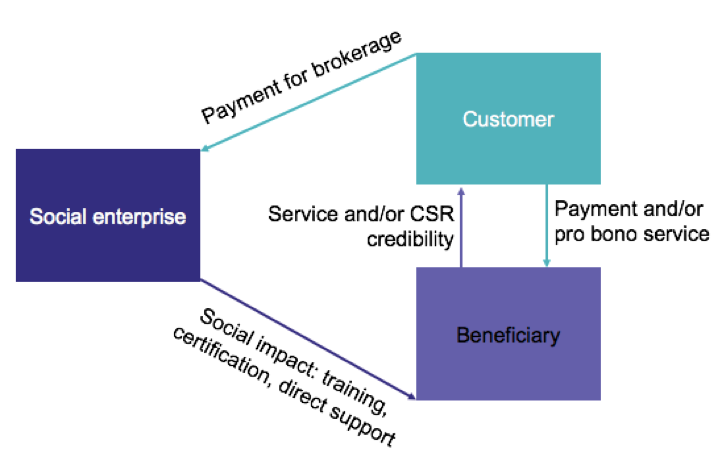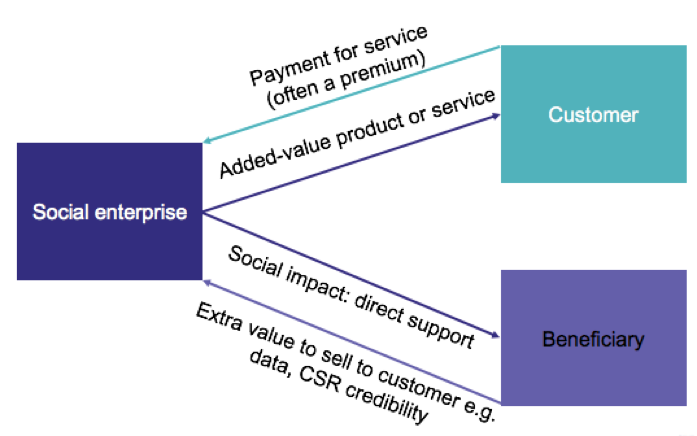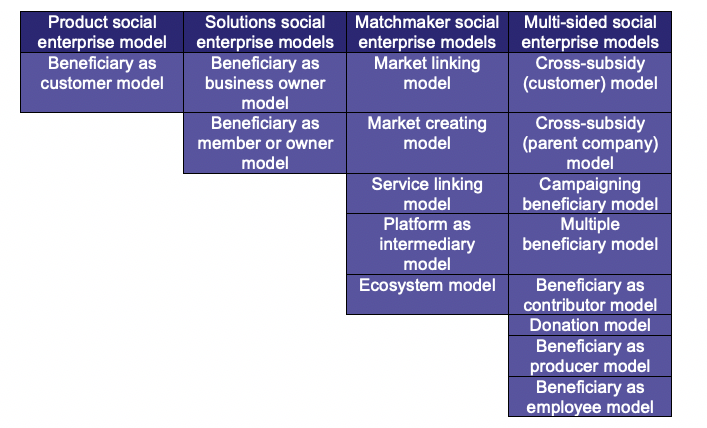Reimagining Your Social Enterprise Business Model Post COVID-19 (Part Two): The 16 Model Types

After the shakeup of Covid-19, many of us will be in crisis and survival mode. But now is also the time to be thinking about the future and recovery phase. There will be new market opportunities as services and products are reimagined, new needs from our communities, and a more open space for business models with purpose as we question an economic system that valued GDP above all else.
This three part blog series explores the what and how of social enterprise business models. It’s a summary of the social enterprise business model toolkit based on 92 international journal articles and interviews with leaders of social enterprise peak bodies in the UK that support over 10,000 social enterprises.
In part one, I shared the components of a social enterprise business model and the trade-offs that have to be managed.
Part two of the series explores the four components of a social enterprise business model and the 16 social enterprise model types. There is no magic formula (sorry!), but the types are designed to spark ideas for how you might refresh or build your own social enterprise business model.
The four social enterprise model categories
There are four basic business model types that explain the different ways that value is created and captured in corporate organisations. These are described in the Business Model Zoo developed by Cass Business School. In the social enterprise business model toolkit, each of these business model types has been adapted to apply to social enterprises.
Product social enterprise models
Product social enterprise models involve a standardised product sold to customers, who are also beneficiaries (generally at a more affordable price). In this model the value proposition for customers and beneficiaries is integrated – social impact and profit are delivered simultaneously.

Solutions social enterprise models
Solutions social enterprise models involve a customised solution developed with a customer. In this model the beneficiary is also the customer (paying a standard or reduced rate). It differs from the product model because the social enterprise engages with the customer/beneficiary about their needs and then provides an integrated solution – it tends to be service delivery. In this model the value proposition for customers and beneficiaries is integrated – social impact and profit are delivered simultaneously.

Matchmaker social enterprise models
Matchmaker social enterprise models use brokerage to connect customers and beneficiaries. Income is usually created through a fee based on ‘trades’ between the two groups. The model relies on generating trust. Value is created by reducing the search effort for customers and offering a marketplace to beneficiaries or subsidised access to support services from the brokering social enterprise. In this model the value proposition for customers and beneficiaries is parallel – social impact and profit are delivered separately through different customer/beneficiary markets.

Multisided social enterprise models
Multisided models involve brokerage between three parties. The social enterprise establishes a set of relationships between previously disconnected but complementary customers and beneficiaries. In this model the value proposition for customers and beneficiaries is parallel – social impact and profit are delivered separately through different customer/beneficiary markets.
The beneficiaries receive products or services at below cost, paid for by customers who gain from the ‘consumption’ of the beneficiary group (for example, delivery of social impact or enhanced CSR credentials). The model generally relies on ‘conscious’ customers paying a premium for services that include delivery of social impact.

The 16 social enterprise model types
Across each of these four business model types, a review of 92 international journal articles identified 16 types of social enterprise business models. These types can be adapted and combined, so are designed to spark ideas about how your business model might shift in response to Covid-19.
Beneficiary as customer model
Social enterprise offers a product of service to a beneficiary who pays an affordable price. Products are produced cheaply (e.g. smaller packages or basic quality) and sold at a low price. Social impact is generated in direct proportion to commercial activity (the more product sold, the higher the social impact).
Example: Ruby Cup in Africa – addresses the lack of menstrual hygiene among low-income women through an affordable menstruation cup made of silicon.
Beneficiary as business owner model
Social enterprise sells business support and financial services to beneficiaries to start/run their own business. This model could include any consultancy or financial services specifically for social enterprises.
Example: Pro Mujer in Bolivia, Nicaragua, Peru and Mexico – offers microfinance and training in business development. The financial model is similar to a bank’s: interest is charged on each loan and savings deposits are leveraged for on-lending.
Beneficiary as member or owner model
Beneficiaries are either members, or own and run the social enterprise in a formal cooperative structure. Members receive services such as market information, technical assistance, collective bargaining power or economies of bulk purchase. Members invest in the cooperative through their time, money or labour. Income is generated through membership fees or sale of products and services to separate customers.
Example: Equal Exchange in the US – a fair trade coffee company legally structured as an employee-owned cooperative. It purchases coffee beans and cocoa directly from its membership of small democratically-run farmer cooperatives in developing countries. It uses educational marketing campaigns to sell the product at a premium and return the above market premiums to members and provides affordable pre-harvest credit.
Market linking model
Social enterprise acts as an intermediary to connect beneficiaries with markets for their products or services. This could be as part of a sustainable supply chain, or on a one-off basis. Income streams are linked to direct fees or revenue sharing agreements as part of new contracts.
Example: Social Traders Australia – certifies social enterprises then facilitates deals between social enterprises and corporate and government customers.
Market creating model
Social enterprise sells the beneficiary’s product or service for them. The social enterprise adds value to beneficiary-made products through product development, production and marketing assistance. The market intermediary either purchases the beneficiary-made products outright or takes them on consignment, and then sells the products in high margin markets at a mark-up.
Example: TOPLA in Haiti – manages the marketing, sales and distribution functions for food products produced by local women. It adds value by improving quality, productivity and enhancing product standardisation with basic, semi-industrial processing equipment. It creates economies of bulk purchase for raw materials, bringing down manufacturing costs and increasing profit margins, which are passed on to beneficiaries.
Service linking model
Social enterprise integrates previously disconnected beneficiaries and customers in the same intervention e.g. complementary needs matching. The high profit margin customer subsidises the offer for the beneficiary.
Example: Auticon in Germany – trains people with autism and matches them with qualified job opportunities in the IT sector.
Platform as intermediary model
Use of an online platform to connect two previously disconnected sides (e.g. a donor and a fundraiser, or a lender and a borrower). There are three types – crowd-funding platforms, peer-lending platforms and ‘reward’ platforms that give cash for sharing digital content.
Examples: JustGiving – connecting donors and social enterprises.
Ecosystem model
Social enterprise facilitates collaboration between related social enterprise products and services to create a more valuable ecosystem. For example, ski resorts are not successful until the complete infrastructure consisting of ski lifts, restaurants, hotels, shops, transport or entertainment is established. This social enterprise plays a coordinating role in the ecosystem.
Example: Cristalino Lodge in the Amazonas region – coordinates an ecolodge, an environmentally-friendly tour operator employing mostly local people, and biodiversity research to improve conservation measures. Every additional participant in the ecosystem adds value by increasing the attractiveness for tourists.
Cross-subsidy (customer) model
Social enterprise serves a customer group and uses revenues to support a beneficiary group. Interventions for beneficiaries are separate to core commercial activity, but activities use the same organisational assets. This model relies on adding ‘social elements’ to a product or service to generate a price premium to enable cross-subsidy.
Example: Associacao Nacional de Cooperacao Agricola in Brazil – runs literacy training and creates educational materials for beneficiaries. It sells similar services to community activists who pay a fee to subsidise the costs for beneficiaries.
Cross-subsidy (parent company) model
Social enterprise generates revenue from customers for a parent company to serve a beneficiary group. The social enterprise is used as a funding mechanism for the parent company, often structured as a subsidiary of the parent company.
Example: Para la Salud in Guatemala – a chain of village pharmacies that generate profit to cover the operational costs of rural clinics for a national health organisation (as well as functioning as a distribution channel for medicines).
Campaigning beneficiary model
This model is focussed on justice issues, social inclusion, building movements and community outreach. It involves two beneficiary groups – one beneficiary group that needs support to access their rights (students, citizens, immigrants or local communities) and one that needs support to campaign for disadvantaged groups access their rights (individuals trained as volunteering mentors, campaign groups, politicians or individuals of the same social group as the beneficiaries). Beneficiaries may pay a small fee that may also be subsidised by donors.
Example: Avaaz (global) – empowers millions of people from all walks of life to take action on pressing global, regional and national issues, from corruption and poverty to conflict and climate change. Avaaz coordinates petitions, funding media campaigns and direct actions (emailing, calling and lobbying governments), and organising “offline” protests and events. The goals is to ensure that the views and values of the world’s people inform the decisions that affect us all. It’s funded through member fees.
Multiple beneficiary model
Social enterprise serves one beneficiary group, engages a second beneficiary group who volunteers, funded by corporate relationships.
Example: Wheelmap – a crowd-sourced online map of wheelchair-accessible places around the world. Wheelchair users (beneficiary one) work pro bono to create data for the map. People/businesses wanting to support wheelchair users (beneficiary two) get free information. Revenue is generated from alliances with wheelchair manufacturers, city authorities and event managers.
Beneficiary as contributor model
Social enterprise engages beneficiaries to provide inputs (e.g. data) that are sold to customers.
Example: co2online in Germany – free online tools to enable users to track and reduce CO2 emissions and costs through comparison with national trends. The beneficiary group input their data and use the tool free. Information and statistics from users are marketed to companies.
Donation model
Social enterprise that does not generate social impact itself, but buys social impact elsewhere by giving its profits to another social enterprise.
Example: Belu Water in the UK – sells environmentally friendly bottled water and gives all profit to WaterAid.
Beneficiary as producer model
Social enterprise manipulates trade relations to increase income for poor producers by charging premiums to conscious consumers.
Example: Fairtrade International – works with businesses, consumers and campaigners to secure better deals for farmers and workers.
Beneficiary as employee model
Social enterprise employs and trains beneficiaries and sells products or services to a separate customer group. The model relies on attracting conscious customers that will pay a premium for the social impact generated.
Example: Fifteen in London – top class restaurants giving disadvantaged young people (homeless and unemployed, overcoming drug or alcohol problems) the chance to gain professional training and to start a career in the restaurant industry.
Summary
While there is no magic formula for social enterprise business model design, these 17 social enterprise model types offer ‘ready to wear’ models as a starting point for combining profit and social impact. Business model design in practice will always require strong contextual understanding, along with creativity and imagination.

The next question is how to develop or improve a social enterprise model. Part three in this series will cover seven steps to consider in social enterprise model design.
Tara Anderson is a social sector executive and Board member specialising in strategy, business models, marketing and multi-partner collaboration. She’s worked across large charities, leading social enterprises and social enterprise peak bodies in Australia, the UK and Europe. She has an MBA from Cass Business School (UK), an MA in Social Innovation (Austria) and a BA in Communications (Australia). She is currently a director and co-founder at The Dragonfly Collective (an international social sector consultancy), leads on marketing at Social Traders (building a social enterprise marketplace across Australia), and is a strategic marketing advisor for On Purpose (social enterprise leadership development in UK/Europe).



No Comments